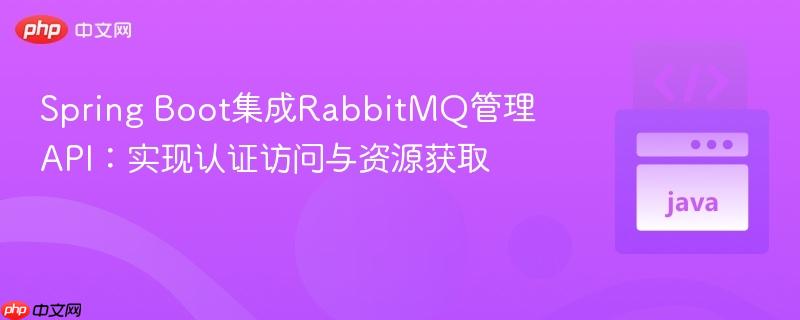
本文旨在解决spring boot应用在访问rabbitmq http管理api时遇到的`401 unauthorized`错误。文章详细阐述了该错误产生的原因,并提供了使用`resttemplate`结合`basicauthorizationinterceptor`实现http basic认证的解决方案。通过示例代码,指导开发者如何安全地从rabbitmq管理api获取队列和交换机信息,确保api调用的顺利执行。
1. 理解RabbitMQ管理API认证与401 Unauthorized错误
在Spring Boot应用中与RabbitMQ交互时,我们通常通过AMQP协议(默认端口5672)进行消息的生产和消费。然而,当需要获取RabbitMQ服务器上的队列、交换机等元数据信息时,通常会使用RabbitMQ提供的HTTP管理API(默认端口15672)。
当尝试通过RestTemplate访问RabbitMQ管理API(例如http://localhost:8080/api/queues)时,如果收到org.springframework.web.client.HttpClientErrorException$Unauthorized: 401 Unauthorized错误,这表明HTTP请求由于缺乏有效的认证信息而被服务器拒绝。
即使在application.properties中配置了spring.rabbitmq.username和spring.rabbitmq.password,这些凭据也主要用于AMQP连接。RabbitMQ的HTTP管理API是独立的,它需要通过HTTP Basic Authentication来验证请求。RestTemplate在默认情况下并不会自动为HTTP请求添加认证头。
原始问题中的代码示例(存在认证问题):
以下是导致401 Unauthorized错误的典型代码结构:
// application.properties 部分配置 spring.rabbitmq.host=localhost spring.rabbitmq.port=5672 spring.rabbitmq.username=guest // AMQP 用户名 spring.rabbitmq.password=guest // AMQP 密码 rabbitmq-api-url = http://localhost:8080/api/ // RabbitMQ API URL,注意端口号 // StartupCLass.java (应用启动时执行的组件) @Component public class StartupCLass implements ApplicationListener{ @Value("${rabbitmq-api-url}") private String endpoint; @Override public void onApplicationEvent(ApplicationReadyEvent event) { RestTemplate restTemplate = new RestTemplate(); // 此处缺少认证信息,导致HTTP请求被拒绝,返回401错误 ResponseEntity response = restTemplate.getForEntity(endpoint + "queues", String.class); // ... 后续处理逻辑 } }
2. 使用RestTemplate实现HTTP Basic认证
解决401 Unauthorized错误的关键在于为RestTemplate配置HTTP Basic Authentication。Spring框架提供了BasicAuthorizationInterceptor,可以方便地将认证信息添加到HTTP请求头中。
核心解决方案:
通过向RestTemplate的拦截器链中添加BasicAuthorizationInterceptor,我们可以在每次请求发送前自动注入Base64编码的Authorization: Basic
import org.springframework.http.ResponseEntity; import org.springframework.web.client.RestTemplate; import org.springframework.http.client.support.BasicAuthorizationInterceptor; import org.springframework.beans.factory.annotation.Value; import org.springframework.stereotype.Component; import org.springframework.context.ApplicationListener; import org.springframework.boot.context.event.ApplicationReadyEvent; @Component public class StartupCLass implements ApplicationListener{ @Value("${rabbitmq-api-url}") private String rabbitmqApiUrl; // RabbitMQ 管理API的URL @Value("${rabbitmq.api.username:guest}") // 从配置中获取API用户名,提供默认值 private String apiUsername; @Value("${rabbitmq.api.password:guest}") // 从配置中获取API密码,提供默认值 private String apiPassword; @Override public void onApplicationEvent(ApplicationReadyEvent event) { RestTemplate restTemplate = new RestTemplate(); // 添加Basic Authorization拦截器,传入API的用户名和密码 restTemplate.getInterceptors().add( new BasicAuthorizationInterceptor(apiUsername, apiPassword)); try { // 访问RabbitMQ管理API获取队列信息 ResponseEntity queuesResponse = restTemplate.getForEntity(rabbitmqApiUrl + "queues", String.class); if (queuesResponse.getStatusCode().is2xxSuccessful()) { System.out.println("成功获取队列信息 (前200字符): " + queuesResponse.getBody().substring(0, Math.min(queuesResponse.getBody().length(), 200)) + "..."); // 在此处解析JSON响应并进行后续处理,例如与本地JSON文件比较 } else { System.err.println("获取队列






























